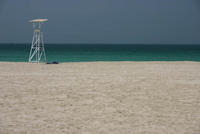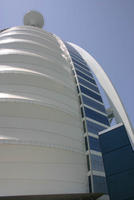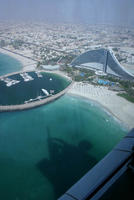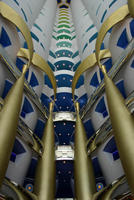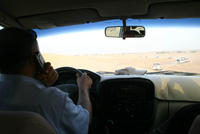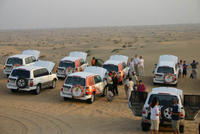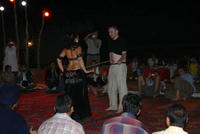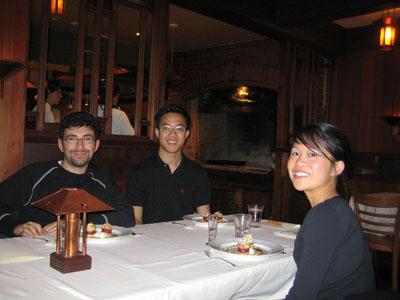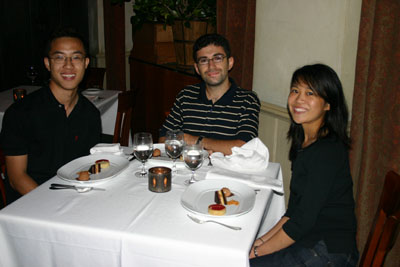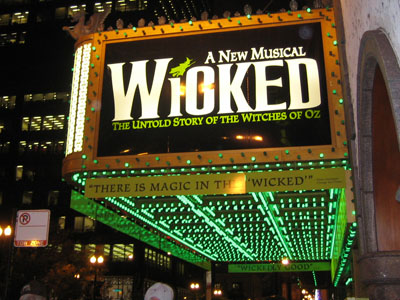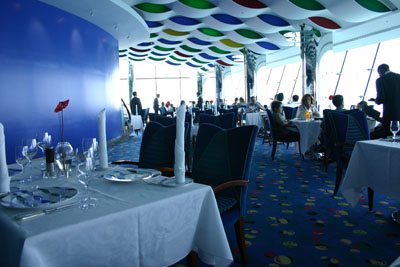I wake up to an SMS from an aunt in Singapore. It was only yesterday that she discovered I was going to Dubai alone and decided to send me the contact details of a friend she has there called Sanjay. “He’s abt 25. Met him in New Orleans in June. Nice guy. 1 of us insurance pple. doin VERY well,” says the message.
I grab a quick breakfast at the buffet restaurant downstairs and give Sanjay a call. He is all too accommodating and after a brief discussion about my plans over the next three days, we decide to meet up for lunch since I’ll be near his workplace in the Bur Dubai region.
My first destination is the Dubai museum, built in the two-century old al Fahidi fort. There are a few artifacts lying around the courtyard, including a cannon, a model of a dhow, musical instruments, old weapons and a nifty windtower structure called an al Barajeel. Windtowers were an ancient form of air-conditioning in which a tower several metres high channelled air down to a room via four openings. As the air moves down it speeds up which has a cooling effect. By convection, this cooler air pulls in the hotter outside air, which is in turn cooled as well. The effect is a refreshing, light breeze wafting from the tower base even when there is no detectable wind outside.
However, the real show is downstairs, where well maintained displays detail the history and development of Dubai, and the various aspects of its rich cultural heritage. There are exhibits about the Bedouins, Dubai’s relationship with the sea and fishing, Islam, camels and so on. Particularly uncanny was the use of holograms combined with models – in one, detailing the composition of an old grave, the grave’s dome cover faded from opaqueness to invisibility to reveal its contents, and then back again.
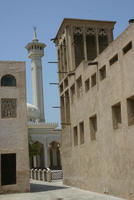 Around the corner from the museum is the old Bastakia Quarter. But even old Dubai doesn’t look that old anymore and extensive restoration work has produced a block of freshly painted and well-maintained historical buildings. Still, it is an interesting site where you can see both the crescent topped minarets of mosques as well as modern skyscrapers framed between narrow alleys lined with centuries-old windtowers.
Around the corner from the museum is the old Bastakia Quarter. But even old Dubai doesn’t look that old anymore and extensive restoration work has produced a block of freshly painted and well-maintained historical buildings. Still, it is an interesting site where you can see both the crescent topped minarets of mosques as well as modern skyscrapers framed between narrow alleys lined with centuries-old windtowers.
I get in contact with Sanjay again. He tells me he’ll pick me up on a nearby corner and to be on the lookout for a white Mercedes. Apart from this and knowing from his name that he’s Indian, I have no idea who to expect. A gleaming new Mercedes 350SLK pulls around the corner driven by a man in sharp business suit. It has to be him. I’m more than a little sweaty after walking in the humid streets for an hour and I apologetically climb into the car, sinking into the convertible’s low seats as Sanjay gives me a hearty handshake.
I have lunch with his family at their apartment. Two “helpers” – otherwise known as maids in Asia, but male – serve a mixture of Indian and Chinese cuisine and I learn that Sanjay and his father operate an insurance brokerage business. It turns out that Sanjay’s specialty is life insurance – the same field as my aunt. As with most successful salespeople, Sanjay’s personality makes him instantly likeable and he offers to take me for a bit of a drive through Dubai after lunch, since actual lunchtime in Dubai extends for several hours in the afternoon, much like for the European countries bordering the Mediterranean.
Minutes later we’re cruising down Sheikh Zayed Road, an eight, sometimes ten, laned highway forming the backbone down the Gulf coast on which the “suburb” of Jumeirah hangs. Replete with its expensive condominiums, plush office towers and horde of cranes working on the next big, ambitious property development project, Sheikh Zayed Road hosts Dubai’s modern, dynamic, and constantly growing skyline. The exciting thing is that none of this existed just two decades ago.
Going back several centuries to the time when the colonial powers of Portugal, France, the Netherlands and Britain were present in the region seeking to control the trade routes, Dubai was a sleepy fishing village on the south-west shore of Dubai Creek in the part of town which is today called Bur Dubai. By the time Dubai had expanded across the Creek in 1841 (today’s Deira district), the British East India Company had finally established a presence in the region. These links to Britain, combined with a tax exemption for foreign traders instituted in 1894 started the growth of Dubai as a trading port. Free trade is still an aspect of Dubai which remains today. With the arrival of the Great Depression in the 1930s, Dubai’s pearl diving industry collapsed and the focus moved more or less solely to trade.
Dubai engaged in a lot of re-exporting the importation of goods for the purpose of exporting them again. In 1947, India, in an attempt to stabilise its volatile currency, banned the importation of gold. Consequently, Dubai became infamous for being a gold smuggler’s staging point. Gold prices in Dubai were half as much as in India and smugglers, operating legally in Dubai (but obviously not in India) pocketed some hefty profits. The construction of new ports and trading facilities saw Dubai eventually surpass neighbouring ports as the trading centre of choice.
In 1971, after Britain departed from the region, the United Arab Emirates was formed the only federation of Arab states to date. Dubai took its place within the federation as the largest emirate apart from Abu Dhabi. Under the federation, emirates are left largely autonomous and Dubai remains a free economic zone.
Sanjay dismisses the old part of town, Deira, as quaint but mostly irrelevant. Jumeirah is where it’s at today. In fact, he tells me he hasn’t been across the Creek for several months. As we drive further down the coast, business and commerce give way to pleasure and entertainment as the first of a crop of five star hotels and beach resorts begin to materialise on the skyline. Sanjay inquires if I’d like to see the new house that his family will be moving into soon. Of course I do, so we turn into a residential suburb filled with nothing less than streets upon streets of mansions.
 There are Indian construction workers crawling all over the house we arrive at. Sanjay has a quick chat to one of them to see how work is progressing and invites me upstairs for a better look. From the balcony, the famous gigantic sail silhouette of the Burj al Arab looms in the distance. Although the Emrati nationals own virtually all the actual land in Dubai, that hasn’t stopped affluent expats from renting out land for their own needs. That’s the case with Sanjay’s family and despite having only a five year lease, they’ve decided to make extensive renovations to the house, including installing a pool, pool house, jacuzzi and snooker room.
There are Indian construction workers crawling all over the house we arrive at. Sanjay has a quick chat to one of them to see how work is progressing and invites me upstairs for a better look. From the balcony, the famous gigantic sail silhouette of the Burj al Arab looms in the distance. Although the Emrati nationals own virtually all the actual land in Dubai, that hasn’t stopped affluent expats from renting out land for their own needs. That’s the case with Sanjay’s family and despite having only a five year lease, they’ve decided to make extensive renovations to the house, including installing a pool, pool house, jacuzzi and snooker room.
The Middle East is a part of the world long plagued with instability. Together with the recent focus on terrorism and Muslim extremists, people tend to paint the entire region with a broad brush. This brush normally colours Arab governments as theocratic, stringently conservative and severely strict, in line with a restricted interpretation of Islam. Friends back in Australia even went so far as to query whether I would be targeted in Dubai as an infidel and treated accordingly. While it may be true that certain parts of the region are more “traditional” than others, it would erroneous to brand everything Arabian as such.
I remark that Dubai, even from the short time I had been here, seemed quite progressive and relatively liberal. “Oh yes, it’s very liberal here. As long as you maintain a respect for certain aspects of Muslim culture, people are pretty much free to do what they want. For one, alcohol is allowed, though it is quite expensive.”
As we exit the residential estate, Sanjay points out a particularly large mansion to me. It’s the Sheikh’s house, or at least, one of his houses. It is the leadership of the Al-Maktoum ruling family that has made Dubai the place it is today.
In 1966, Dubai struck oil. Sheikh Rashid, the emir at the time and regarded as the “father of modern Dubai”, put the oil to good use. Oil revenue was poured into infrastructure and development. It also enabled the elimination of personal income tax, free health care and free education for citizens. Sheikh Rashid’s work has been continued by his son, Sheikh Maktoum and the current Crown Prince, Sheikh Mohammed. This rapid development has earnt Dubai the moniker of “Dubai Inc.” by some and even The Economist has remarked that “Dubai is run like a family business by a benign autocrat”. Sometimes it’s referred to as the Hong Kong or Singapore of the Middle East.
Only about 6% of Dubai’s income comes from oil. Oil supplies are forecasted to run out within a decade so it is not all that surprising that Dubai is not fuelled by oil, but by services, trade and increasingly tourism. The royal family-owned and profitable Emirates Airlines, combined with events such as the Dubai Fashion Week, Dubai Shopping Festival, Dubai Desert Classic golf tournament and Dubai International Racing Carnival have all helped to put Dubai on the international map.
Accompanying this capitalism success story is an extraordinary level of multiculturalism in Dubai. Sanjay’s father arrived in Dubai shortly after the UAE was formed and slowly built up the family business from there. At some point during lunch, I mentioned that I’d booked myself in for a desert safari. Sanjay’s father interrogates me about who I’ve booked with and how much it will cost me. He turns to Sanjay and after a quick exchange in Hindi, he tells me to cancel the booking because he could net me at least a 50% discount. I ask if he also knows how to speak Arabic and am surprised to discover that he didn’t. “There are so many expats here, the Arabs better learn how to speak something else if they want to do business!” he says.
Emrati nationals only comprise 20% of Dubai’s population, the rest being expats. The majority of expats hail from India, with a sizeable chunk coming from Iran, Pakistan, and, strangely enough, the Philippines. It is the expats that provide a cheap labour force and fill Dubai with a rich mix of religion, dress and language. As is so often the case where people speak different languages, English has become the de facto language of commerce and Dubai is no exception.
As multicultural as things were, there didn’t seem to be much blending between the different peoples, with communities seeming to mix predominantly among themselves.
Unfortunately Sanjay has to head back to work to close off a deal with an international client. I bid him farewell and he drops me off at Mercato Mall to check out the shopping scene. Shopping is a big pastime in Dubai, and the shopping malls are certainly impressive. Even though the rest of Dubai has shut down for the afternoon (for a Mediterranean-style siesta), the malls are one of the few places that remain open. It’s buzzing despite being a Wednesday. Mercato Mall is relatively small, but it has some wonderful architecture modelled on an Italian style. I also manage to visit Wafi City Mall and Deira City Centre that afternoon. Wafi has a fair amount of affluence flowing through it and I was strongly advised by Sanjay to only look, and if the temptation to buy should arise, I should strongly think it over. Boutiques line the corridors of Wafi and the price tags dangling off the little bits of cloth and stones displayed in the storefront windows had an impossible number of digits written on them. On the other hand, Deira City Centre is more a mall for the masses. It’s pretty darn big. Despite being only three levels, it encompasses a fair chunk of real estate. Carrefour has built one of its “Hypermarkets” inside which features over fifty checkout counters… all of which were in use when I visited.
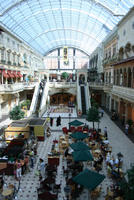 Multiculturalism is especially evident in the shopping malls. Sitting in one of the rest-stop cafes, I found it fascinating to observe Arab men in traditional white robes and Muslim women swathed entirely in black burqa and hijab walk alongside caucasian girls with miniskirts and low cut tops. Stores are staffed by a multitude of Indians and a liberal sprinkling of Asians – mostly from the Philippines. One thing I found particularly noteworthy was the quality of talent in those malls. I’m sad to say that while in Singapore it was a tough task finding the attractive people, in Dubai it was a tough task finding unattractive people. Maybe I was just there on the right day, but it was quite a sight nonetheless.
Multiculturalism is especially evident in the shopping malls. Sitting in one of the rest-stop cafes, I found it fascinating to observe Arab men in traditional white robes and Muslim women swathed entirely in black burqa and hijab walk alongside caucasian girls with miniskirts and low cut tops. Stores are staffed by a multitude of Indians and a liberal sprinkling of Asians – mostly from the Philippines. One thing I found particularly noteworthy was the quality of talent in those malls. I’m sad to say that while in Singapore it was a tough task finding the attractive people, in Dubai it was a tough task finding unattractive people. Maybe I was just there on the right day, but it was quite a sight nonetheless.
On the way back to the hotel, I pass by a bus station where a crowd of Indians had gathered around a small television set which was screening the fourth Ashes test. I inquire about the score and am disappointed to learn that England, batting first in the first innings, was in the middle of a sizeable partnership. “You’re Australian? That Shane Warne is really something,” one Indian remarks to me. “He is, isn’t he?” I replied. (Unfortunately, despite the heroic efforts of Warney, Australia later went on to lose the Ashes series 2-1 and British news featured nothing but the victory for the next few days.)
The next day I arrive at Jumeirah Mosque for their 11.00am “Open doors, open minds, mosque visit program,” a Sheikh Mohammed initiative. I arrive early to find the mosque doors shut. There’s only a handful of other tourists milling around, similarly wondering where to go. However, as 11.00am draws nearer, a sizeable crowd has formed at the mosque entrance. Finally, a decorous woman emerges from behind the door and welcomes us. There’s a little delay while everyone removes their shoes and the more immodestly attired among us get additional clothing distributed to them. Then we are ushered into the thankfully air-conditioned mosque. Like any typical mosque, its floor is empty, save for several pillars. There is no central point of worship, like a Buddhist shrine or Christian altar, with only a marker (mihrab) on one wall indicating the direction to Mecca. An electronic board listing the day’s prayer times, a stack of books, a couple of microphones and a seat for the Imam are all that fill the mosque apart from the fifty or so tourists which have invaded and are now scampering around taking photos of themselves in their new burqas.
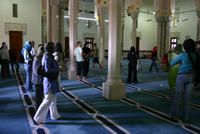

Our tour guide introduces herself and explains the tour is not so much a tour as it is a lecture with a Q&A session. She decides not to use a microphone because the group is smaller than the one or two hundred visitors that normally attend. A quick survey via a show of hands reveals that there are two North Americans, a couple of South Africans, some Asians and a rather sizeable contingent of Australians comprising the crowd. The remaining half are European. This included our tour guide, who explained that she was originally a Swiss born in Lausanne who was raised as a Catholic before she converted to Islam. She moved to Dubai several years ago.
The talk is aimed at clearing up the misconceptions commonly held about Islam. Our guide quickly explains that shoes are not allowed in mosques for the practical reason that Muslims pray with their faces to the floor, and who wants to do that with a dirty floor?
Some time is spent explaining the five pillars of Islam: the Shahada an expression affirming the monotheistic nature of God and the prophethood of Mohammed; the Zakat, essentially the necessity for charity; fasting during Ramadan; the Hajj, or pilgrimage to Mecca for those able to go; and the Salaah, or the five daily prayers.
Our guide explains that praying towards Mecca acts as a focal point. Interestingly, because I had not visualised it in this way before, Muslims take heart in knowing that everyone else praying around the world at the same time as them are all facing towards one central location.
Prayers are performed five times a day, the first being at dawn. An Azan, or call to prayer, is sung out from loudspeakers on mosque minarets to remind people that they have to pray soon (that is, they don’t have to drop everything immediately). A muezzin (person who performs the Azan) comes out and gives us a demonstration and the Arabic is translated into English for us.
“What if dawn comes at 5.00am?” one woman asks. “A bit early to get out of bed, isn’t it?”
Our guide agrees, but notes that there is nothing to stop someone from crawling back into bed after dawn prayers. However, getting out of bed for the few minutes of the prayer is a sign of dedication to the faith. She adds with a smile that the Azan is slightly modified at dawn: the sentence, “prayer is better than sleep” (repeated twice) is added to it.
When the floor is opened to questions, they come in thick and fast and all seem to be probing at the status of women in Islam. Most people are concerned. Most of these things are explained away as merely cultural developments, as opposed to religious ones. Traditionally, there is Muslim men and women (presumably outside of the same family) do not mingle. Veils and full-length garb are all about hiding women’s features, helping them feel comfortable while walking down the street and not being stared at. Similarly, separation of genders during prayer is not a matter of segregation (women are not disallowed from using the main prayer room) but comfort. In terms of why all women’s clothing in the region is black, black is chosen due to its neutral status as a colour, but other cultures do wear other colours for example, the colourful abbeyas of Malay women.
Perhaps unfortunately there is little discussion about the beliefs of Islam, with the focus mainly on rituals and customs. It comes as a surprise to many that Islam and Christianity share many commonalities acknowledgement of Abraham and Moses as prophets, acknowledgment that the Old and New Testaments are relevations from God (although Islam believes the Qur’an replaces the Holy Bible) and so on.
I do discover, however, the answer to a question I have had for a long time, and that is that “Allah” is used as the Arabic word for God by Christian Arabs too.
It is certainly an interesting morning, but I still have reservations that other States in the region employ a view as permissive as Dubai’s. Nonetheless, the Jumeirah Mosque visit program is an excellent thing to have, especially in this day and age. I remain a steadfast Christian, but found the talk very instructive.
Nearby the mosque is a public beach where the brilliant azure waters of the Gulf lap gently onto the shore. The peak of summer had past about a month ago, but Dubai was still incredibly hot and humid. I test the water and find it to be surprisingly warm. Unfortunately I have brought no clothes to swim with and besides, I have a lunchtime reservation at a restaurant to keep, so I find alternative relief from the heat in the comfort of an air-conditioned taxi.
“It’s a hot day isn’t it!” my Iranian cab driver observes with a chuckle as I wipe my face down with a tissue. For some cruel reason, all the taxis in Dubai seem to be equipped with outside temperature gauges, and the one in this taxi is reading in the mid-40s. “But don’t worry,” he reassures, “if you came one month earlier, it is over 50 degrees.”
My next destination is the Burj Al Arab. Modelled after a billowing sail, the Burj is a central icon of Dubai. Although debate continues on whether the hotel is, on the official scale, a 7 star hotel, or merely a “5 star deluxe” one, with rack rates for its suites (there are no regular “rooms”) starting at around US$2000, it’s probably beyond debate that it’s the world’s finest, and tallest, hotel. (Incidentally, I had stayed at the world’s second highest hotel the Baiyoke Sky, which is 13 metres shorter in Bangkok only a week earlier. It was much less extravagant.) So rarified is the Burj’s air, that it is built on an artificial island several hundred metres off the coast “to protect the privacy of guests”. Entry is usually restricted to hotel guests, unless you pay a US$55 entry fee. It’s rumoured to have cost so much money to build that the hotel will have to run at full occupancy for several centuries in order to be paid off. This would make the building an Emrati landmark rather than a viable commercial venture.
After a while my driver asks if I am staying at the hotel, to which I promptly answer, “I wish!” This multi-billion dollar structure was a must-visit, but since the rates for a night’s stay would fund my backpacking trip for about a month, I was visiting via a lunchtime restaurant reservation, which was only a marginally cheaper proposition.
“She’s beautiful isn’t she?” he rhetorically asks as we drive up the driveway. I can’t stop staring. It actually looks that much better in real life. We are stopped at the front gate by a security guard, who lets us through after satisfying himself that I am on the restaurant reservation list.
Inside, I feel very out of place, expecting someone to rush out and toss me back onto the street. An African bellhop approaches me. “Are you staying here, sir?” he asks.
This time, I resist the urge to blurt out “I wish!” and tell him I’m headed for the restaurant. He directs me up the escalators which are flanked by two gigantic tropical aquariums and an elaborate fountain with a mesmerising jumping water display. At the top of the escalators, the roof opens up into an opulent, soaring triangular atrium. Each level is painted in a different colour, and the result is a gradient of rainbow colours stretching up towards the top of the building. It’s actually all quite gaudy, but everything in this part of the city is so ostentatious it looks perfectly acceptable.
Al Muntaha is the restaurant at the top of the Burj and in addition to serving food it offers great views of the city. Through one window you can see The Palm, a famed property development built on reclaimed land in the shape of a palm tree. The Palm is just one example of the myriad of large-scale property developments in progress. (Sanjay had joked the previous day that the national bird of Dubai was the crane.) Another, larger Palm is scheduled to be built soon after, and yet another reclaimed land project called The World will also open. (Locals joke that when The World is completed, you can live in Paris without leaving Dubai.)
The foundations are already in place for the Burj Dubai, a skyscraper slated to be the world’s tallest upon completion. Developers are keeping the building’s final height a secret, but it is expected to reach over 700 metres and possess 160 floors. A deal being financed by the Chinese government will see a 2 kilometre long shopping mall called the Dragon Mart being constructed as a foothold for Chinese exports into the Middle Eastern market. There is also Dubailand, a massive US$5 billion “tourist city” covering 45,900 acres, aimed at tripling the number of people visiting Dubai by the end of the decade. Almost ludicrous in scale, it will contain 45 theme parks, sports centres and discovery zones, including an indoor ski-slope, an equestrian centre, three sports stadiums, a zoo, and an artifical rainforest. All this being built in the middle of a desert, mind you.
Later in the afternoon, I make my way over to the souks which have begun to reopen. I take an abra across the Creek for the measly fee of 50 fils and hit the perfume, spice and gold souks. Expecting the open air markets of Asia, I am somewhat disappointed to see that the layouts of souks have been modernised. They are all basically covered walkways, lined by merchants hawking their wares in air-conditioned shops. Nonetheless, the gold souk is amazing. By tradition, weddings in the region require brides be given gold which is new, so this ensures a fresh supply of gold flowing through the market. And there is a lot of it. Most of the gold on sale is 24 carat, which is a very deep yellow-orange colour. Window front displays are laden with copious amounts of gold chains, bracelets, rings, pendants and countless other trinkets in a bewildering array of designs and the light reflecting off them radiates a bright, warm glow.
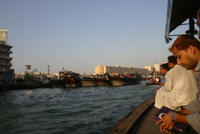
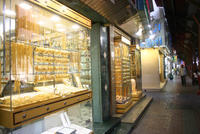
Interestingly, I do not notice any visible security around the gold souk a testament to the low crime rates in the emirate. It is soon twilight, and I decide it is time to leave the glow behind and take a stroll along the creekside and past the dhow wharfage. Thousands upon thousands of boxes sit on the wharfage. They are filled with goods of all descriptions and from all manner of places. Some sit on the wharf unguarded for weeks.
On my final morning in Dubai I have a stroke of good luck. I had only been able to book my hotel for two nights and was without accommodation for my final night. It is low season, but mysteriously all the hotels in the area seem to be booked out. So, just as I am in the process of checking out, backpack in hand and wondering where on earth I am going to go, I decide to ask if any vacancies have opened up overnight. After a bit of tapping on the computer, the receptionist hands my key straight back to me and tells me that I can stay for another night.
When the afternoon comes, it is time to go on the desert safari. A four wheel drive picks me up at the hotel, shared by a British Indian mother-son pair, two Irishmen and a South African living in Zambia with a particularly wry sense of humour. The first activity is sand-duning. We drive about an hour out of the city, past a Sheikh’s compound surrounded by a 2 kilometre wall, and into the desert where we meet up with a convoy of at least ten other four wheel drives all run by the same safari company. Our driver gets out of the car to have a chat with a friend but leaves the engine running. All of us are nervously eyeing the fuel gauge, which is sitting on empty. We had stopped at a service station earlier, but it was only to let some air out of the tires (a lower tire pressure helps when driving on sand).
Five minutes later, our driver is still chatting and the car stalls and dies. Hopefully, it’s not due to the lack of fuel. Meanwhile, the first vehicles in the convoy have started to leave. We look over to our driver, who is chatting with another driver whose car’s bonnet is open. The South African remarks, “They’ve got to be concerned. Their bonnet is open and no one’s fixing it!”
By the time our driver finishes socialising, we are one of only two cars left. Our car refuses to start, but after a few attempts, the engine splutters back to life and everyone breathes a sigh of relief. Then it’s off to the dunes.
“Ok everyone, you might want to buckle up!” our driver tells everyone as we leave the dirt road. There is a barrage of clicks as everyone dons their belts. Then Dave, one of the Irishmen sitting in the backseat calls out, somewhat frantically, “Um, my belt’s broken
it won’t clip in!”
Seconds later we hit the first sand dune and Dave goes flying.
“Well, unfortunately you’re just going to have to hang on tight!” our driver replies, only half-apologetically.
Sand-duning is fun. Really, really fun. Basically it involves going for a hoon around the sand dunes at high speed. It’s like an hour long roller coaster ride in first gear. The cars wrench violently in the sand as they mount a dune and then dive sharply down the other side. Sometimes they decide to drive along the side of a dune and we’re all trying to grab a hold of whatever we can as the car shudders along, tilted at some unnatural angle. The wheels spin rapidly as the car attempts to cling to the dune, throwing up large masses of sand and the engine roars between the creaks and crunches of the car’s suspension.
Then in the middle of it all, our driver gets a phone call on his mobile. And answers it. So there he is, one hand holding a phone, and one hand alternating between the stick and steering wheel, with his knees occasionally helping out with the steering. This guy’s a real pro the rest of us are hanging on for dear life (especially Dave) and he’s handling it all like it’s some Sunday afternoon drive through the neighbourhood.
The cars take quite a beating and I learn that the average lifespan of them is only three years. Ours is fairly new, but apart from Dave’s broken seatbelt, the speedometre has already ceased to function.
The convoy pauses for a while so we can catch the sunset, and all the bonnets are popped open so the cars have a chance to cool down. Then we’re back to sandduning again.
Eventually we arrive at a campsite which is where dinner is being served. Dozens of candlelit tables surround a large carpet in the middle. To the side, there are several tents. One allows people to try on some local clothing. Another demonstrates henna painting for women. A rich, fruity smell wafts from a third tent inside this one tourists get to sample sheesha, a water pipe used for smoking flavoured tobacco. Outside, a bored looking Arab leads two camels around in circles while tourists clamber on and off them for their minute-long camel ride.
The campsite is meant to emulate a typical Bedouin desert encampment, but the whole thing is so touristy and tacky that any resemblance with a genuine Bedouin campsite must be purely coincidental. The food is pretty decent, though, with a mix of regional cuisines.
As dinner begins to wrap up, a large group of men start to congregate on the carpet in the middle of the camp, reclining on some large cushions. I didn’t know what was happening next, but I could guess. And I was right.
Enter a belly-dancer.
She is pretty good at belly-dancing, but nothing particularly special. More interesting is the exhibition of what I can only describe as enthralled lasciviousness by the horde of men encircling her (with their wives sitting a short distance away at the tables, mind you).
Mandeep, the Sikh in our four wheel drive, turned to me and said, “This is like the biggest sausage-fest ever, dude.”
“Yeah man, I was just about to say that,” I agreed.
She calls someone from the crowd and Mandeep and I are amused to see it’s Dave. She rolls up Dave’s shirt and ties it in a knot. Now that his gut is exposed, she gestures him to imitate what she does. He makes a good effort, but is no match for her supple, undulating tummy. We’re all in stiches.
After the show is over, she invites everyone to take the floor and join in with the dancing. About fifty men immediately leap to their feet, all jostling to get beside her. Luckily she is used to the attention and knows how to take control. Then it’s a case of monkey-see, monkey-do as the men try to mimic her moves and fail horribly. It’s morbidly fascinating.
Finally it’s all over, and it’s back to the car. We all take the piss out of Dave for his sterling belly-dancing performance. He can only plead, “Hey guys, whatever happens in Dubai stays in Dubai.”
Our driver finally stops to fill up the petrol tank, and an hour later I am at Dubai International Airport for my 2.00am flight to Europe.







